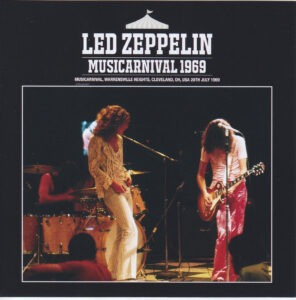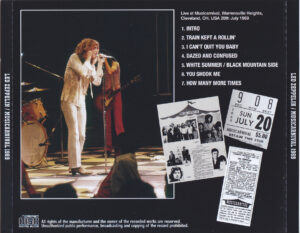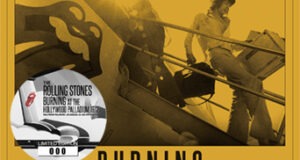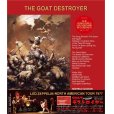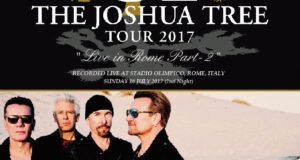Led Zeppelin / MusicCarnival 1969 / 1CD / Non label
Musicarnival, Warrensville Heights, Cleveland, OH, USA 20th July 1969
Play sample :
Led Zeppelin in 1969 was also quite popular on the two US tours in the first half of the year, but the third US landing to further expand was centered around summer festivals. It was a tour. It is a new place to remember that the first day was excavated as “ATLANTA POP FESTIVAL 1969”, but a rare sound source that has existed for a long time as one of the sound sources of this period but was overlooked is July 20th. Cleveland performance. In the olden days, the sound source of the impression that the items were limited and released in detail, such as the old cod board “DESTROYER 1969”.
This was an audience recording that was surprisingly easy to hear, but on the other hand, since hiss noise is a sound source for chronic diseases, the previous old Tara board etc. used noise reduction to twist it down. It can be said that it is a state that is often found in items in the mid-1990s. After that, a few items were released, but the factors that made the impression worse were that the items were released with a feeling of falling out of the gene, and the past items were released with the pitch generally out of order. Wasn’t it?
When releasing such an unfortunate 1969 vintage audience on a limited press CD, the base was the version that appeared on the net earlier this year. This is a state of 2 gen after dubbing twice from the master reel, but the impression is that the state is much calmer than the existing board. In the first place, the pitch was accurate because it was corrected when it was released. This alone made it much easier to hear than past items.
Furthermore, I was worried about the situation where the sound sways due to the deterioration of the tape while recording in monaural like a vintage audience, but that was also resolved at once by the process of re-mono from the right channel at the time of release. This also made it possible to record in a stable state that is incomparable to the state of the existing board.
Although it is basically a distant sound image, on the other hand, the fact that there are no noisy spectators around me also makes a big contribution to the surprising ease of listening to this sound source. In addition to that, this kind of overhaul has finally made it easier to hear.
If you listen in such a stable state, you can see that this day is already in a solid state ahead of the next day’s famous performance, Central Park. However, it has a unique atmosphere that is very careful and polite, yet powerful, rather than an aggressive performance like the next day. It seems that it was decided in the stage situation that the monitor was almost useless on this day, as the plant was talking to the audience.
Not limited to this day, 1969 was the time when stage monitors were introduced in earnest at American rock concerts, so there must have been frequent happenings that they still did not work as expected. In other words, on the stage, we had to play carefully while we couldn’t hear our performance as we expected. Even after being hit by such a disaster, it can be said that ZEP’s 1969 performance is so powerful that it can still be heard.
In fact, the engine of the plant is fully open because it is salty, and the sight of the extraordinary scream that makes the audience laugh was seen the next day, as well as “I Can’t Quit You Baby” and “You Shook Me”. It tells how his singing voice in the Blues repertoire was overwhelming.
Also, of the two tours that took place in the first half of the year, only Ohio University on May 17 (the sound source has not been excavated) visited the suburbs of Ohio, so it will be the first time for many of the spectators who packed up this day to see it. It seems that it was the stage of ZEP, and it may have led to an easy-to-hear sensation as if the scream of the plant was shocking or watching with a sigh.
However, Jimmy’s solo performance “White Summer / Black Mountain Side” ends up with a cut that seems to have stopped recording because the taper got tired of the instrument.
And ZEP itself rushed into the finale “How Many More Times” exploding performance as soon as the monitor malfunctioned. You can often play this much in a situation where you can’t hear your performance. The polite but hot performance, which is totally different from the next day, is very interesting. In the first place, if the day changes, the performance will change drastically. It’s also decided where the song will move to the “Oh Rosie” and “The Hunter” parts.
And it is interesting that there are many quiet developments because the monitor cannot be used. However, it is a chronic disease of this sound source that a little transfer of music unrelated to ZEP to the tape can be seen in the latter half of the 11th minute in the middle of that, but the sound covers the performance of ZEP at the right time, which is surprising. Fortunately, it’s unfortunate that I can overhear without any discomfort (laughs). It’s a joke, but the vintage audience of 1969 ZEP, which had been thought to be a high hurdle until now, will be released this time with a much easier hearing. I was surprised at the performance that was completely different from the next day’s Central Park!
1969年のレッド・ツェッペリンは上半期に行われた二回のアメリカ・ツアーでも相当な人気を獲得していましたが、さらに拡大すべく敢行された三度目のアメリカ上陸が夏のフェス回りを中心としたツアーでした。その初日が「ATLANTA POP FESTIVAL 1969」として発掘されたのは記憶に新しいところですが、この時期の音源の一つとして古くから存在していながら、それでいて見過ごされていたレア音源が7月20日のクリーブランド公演。古くは旧タラ盤「DESTROYER 1969」など、アイテムに限りがあって細々とリリースされていた印象の音源。
こちら意外なほど聞きやすいオーディエンス録音だったのですが、一方でヒスノイズが持病の音源ということから先の旧タラ盤などはノイズリダクションを用いてそれをねじ伏せていたものです。いかにも1990年代半ばのアイテムにありがちな状態と言えるでしょう。その後もわずかにアイテムがリリースされていましたが、ジェネ落ち感マシマシなまま出してしまったもの、なおかつ過去のアイテムは総じてピッチが狂ったままでリリースされていたことが印象を悪くさせてしまった要因だったのではないでしょうか。
そんな不遇の69年ビンテージ・オーディエンスを限定プレスCDでリリースするに際し、ベースとなったのは今年に入ってネット上に現れたバージョン。こちらはマスター・リールから二回のダビングを経た、つまり2 genという状態なのですが、既発盤と比べて随分と状態が落ち着いた印象。そもそもピッチは公開された段階で補正されていたおかげで正確。これだけでも過去のアイテムよりはるかに聞きやすくなっていました。
さらにビンテージ・オーディエンスらしくモノラル録音ながらテープの劣化によって音が揺れるという状態も過去のアイテムで気になったのですが、そこも公開時に右チャンネルからの再モノ化という処理によって一気に解消。これもまた既発盤の状態とは比べ物にならないほど安定した状態での収録を実現してくれたのです。
基本的に遠めな音像ではあるのですが、その一方で回りに騒がしい観客がいないことも、この音源の意外な聞きやすさに大きな貢献を果たしてくれているように思います。そこへ加えてこのようなオーバーホールが施されたことで、いよいよ聞きやすい状態へと生まれ変わってくれました。
そんな安定した状態で聞いてみれば、この日は翌日の名演、セントラル・パークを控えて既に盤石な状態であることが伺えます。ところが、翌日のような攻めた演奏というよりも非常に慎重かつ丁寧、それでいて力強いという独特な雰囲気。それはプラントが観客に向かって語りかけているように、この日はモニターがほとんど使い物にならないというステージ状況の中で決行されたことが要因だと思われます。
この日に限らず、69年といえばアメリカのロックコンサートで本格的にステージ・モニターが導入された時期ですので、まだ思うように作動してくれなったというハプニングが頻発したはず。つまりステージ上では自分たちの演奏を思うように聞き取れなかった中で慎重に演奏するしかなかった。そうした災難に見舞われてもなおこれほどまでに力強い演奏を聞かせるのが69年のZEPの面目躍如と言えるかと。
実際プラントなどはしょっぱなからエンジン全開であり、その桁外れなスクリームがむしろ観客の笑いを誘ってしまう光景などは翌日でも見られたものですし、「I Can’t Quit You Baby」や「You Shook Me」といったブルーズ・レパートリーにおける彼の歌声がいかに圧巻であったかを物語ってくれる。
また上半期に行われた二回のツアーの中でオハイオ近郊を回ったのは5月17日のオハイオ大学(音源は未発掘)だけですので、この日詰めかけた観客の多くにとっては初めて目の当たりにするZEPのステージだったと思われ、それがまたプラントのスクリームに衝撃を受けたり、あるいは固唾を飲んで見守ったかのような聞きやすい臨場感へとつながったのかもしれません。
もっともジミー独演「White Summer / Black Mountain Side」に関してはいかにもテーパーがインストに飽きて録音を止めてしまったようなカットで終わってしまうのですが。
そしてZEP自体はモニターの不調も何のその…とばかりにフィナーレ「How Many More Times」爆裂演奏へと突入。自分たちの演奏が聞き取れていないという状況の中で、よくぞこれほどの演奏ができるものですね。丁寧だがアツい演奏という、翌日とはまるで違う演奏ぶりがとても面白い。そもそも一日変われば演奏がガラッと変わるのがまた69年のZEPの面目躍如というべきか。曲が「Oh Rosie」や「The Hunter」パートに移るところもぴったり決まっている。
そしてモニターが使えていないからこそ静かな展開が多いのが面白いところ。しかしそんな最中の11分台後半でZEPと関係のない音楽のテープへの転写が少しだけ見られるのも本音源の持病なのですが、その音がZEPの演奏にタイミングよく被さっており、意外と違和感なく聞き過ごせてしまうのは不幸中の幸い(笑)。それは冗談ですが、今までハードル高めに思われていた69年ZEPのビンテージ・オーディエンスが今回グッと聞きやすくなってリリースされます。翌日のセントラル・パークとはまるで違う演奏に驚き!
(59:50)
1. Intro
2. Train Kept A Rollin’
3. I Can’t Quit You Baby
4. Dazed And Confused
5. White Summer / Black Mountain Side
6. You Shook Me
7. How Many More Times
Non label
 GiGinJapan Artwork of Japanese CDs (mostly)
GiGinJapan Artwork of Japanese CDs (mostly) 